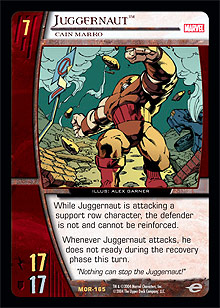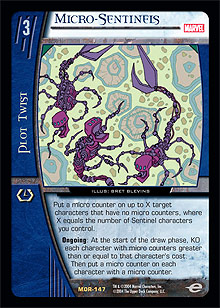Yeah, we all know it by now—I’m all about the tech! Show me a janky deck and I’ll show you why it’s a potential-packed powerhouse. I’ve got a foil Arkham deck and an utter passion for Juggernaut and there’s nothing I can do about it. It’s a disease.
As usual, I was able to identify four key pieces of tech that influenced the course of the day. Or, at least, four cards that people were banking on to give them an edge. The first? My personal pet card!
 Juggernaut
Juggernaut
Eight of the thirty-eight competitors running Curve Sentinels played at least one copy of everyone’s favorite dome-headed maniac. There are no words to describe how much that thrills me. Juggernaut accomplishes many important things in the current metagame, and while I’ve given extended dissertations on it before, it doesn’t hurt to recap. In addition, Juggernaut was run successfully in some ways that I didn’t see coming.
For those uninitiated in my ramblings, I am of the opinion that Juggernaut is the ultimate solution to Curve Sentinels’ main problem: a metagame packed with Betrayal. A pair of Betrayals can turn the most winning of board positions into an utter disaster, auto-stunning characters because, as much as he might hang out with the purple kids, Magneto just isn’t a Sentinel. Juggernaut has no team affiliation, and as a result, Betrayal is a dead card against him. In addition to that, Juggernaut happens to be the largest 7-drop aside from Kalibak, and though his drawback effect limits him from attacking several turns in a row (barring Press the Attack), one shot from him is likely game ending. Even when he’s stuck in exhausted position, he’s still a huge freaking brick, and that’s enough in some matchups.
Against EMS and Fantastic Fun, he’s a total boon. Provided that you can get him into the back row, he can punch through all the pink bubbles and tired policemen either deck can hurl into his path and slam directly into the opponent. While getting to turn 7 against Fantastic Fun can be a tremendous challenge, it’s doable in most cases, and EMS’s turn 7 doesn’t pose any problems beyond the possibility of a massive stun from Dr. Light.
What I found interesting today, though, was how the card was being run. I always figured the way to go was to run four Juggernauts over the traditional four Magnetos, and then replace the four copies of Genosha with two Betrayals for the mirror and two Micro-Sentinels. But several players, including UDE netrep Tay “Locke” Howland, were keeping the Genoshas and finding reasonable levels of success—very interesting.
Valeria Richards
With nine Common Enemy decks seeing play, Valeria Richards was splashed into several decks with mixed results. She’s not a top pick of mine because I find her to be obviously conditional, but the reality is that once she gets settled in and supported, she’s ridiculously powerful. There is essentially no hidden character tech in the current metagame, so when Valeria is locked and loaded she’s almost impossible to get rid of (short of direct stun effects). It’s not brilliant tech, but it is worthy of note.
 Micro-Sentinels
Micro-Sentinels
Okay, I’m cheating—I generally look for unique tech and this isn’t it. But it has to be said; Micro-Sentinels are dominating this event. While their effectiveness lessened over the course of the tournament as the decks they tech were frequently beaten out of the top tables, Micro-Sentinels were everywhere in the early rounds and winning games left, right, and center.
The interesting thing about Micro-Sentinels isn’t just that they tech Evil Medical School and Fantastic Fun, but is actually the long-term effect they have, regardless of matchups. A lot of Curve Sentinel players are running fewer and fewer early game drops, and that sometimes results in a paucity of board presence that destroys the Sentinels’ mid- and late games. Micro-Sentinels is an equalizer, strengthening the mid-game of a CS deck that uses them and evening the odds far more quickly than characters and Overload combos alone can. In short, as odd as it is to think, the cards aren’t just tech—they do actually work as they appear to have been designed to work, compensating for poor draws in the opening turns and allowing Hounds of Ahab to be a safer thing to emphasize.
Roy Harper ◊ Speedy
The last piece of tech for the day is again another old trick with a new spin applied. Speedy is nothing new. He’s good at offing bothersome 1-drops, and since his inception, his impact on Teen Titans decks has been understood.
The cool part? Competitors at $10K Detroit were splashing him into decks that didn’t normally use him. Brave and the Bold? Understandable. But Force? TNB? There were some odd choices being made and they seemed to be working.
While the potential to Speedy away multiple characters in the same turn makes this card truly great in Teen Titans decks, other decks don’t have that. But other decks can still take advantage of this interesting drop-filler, especially those that have few or no drop-filling effects. It’s too difficult at this point to predict where Speedy may see play, but as competitive players continue to move towards drop-filling trends, he might be popping up in a lot of weird places.
So, that’s what piqued my interest at $10K Detroit. Micro-Sentinels continued to gain popularity, Juggernaut had his first major breakthrough (yay!), and Speedy and Valeria Richards popped up in odd places—Speedy in peculiar decks, and Valeria in, say, cupboards and dumpsters, hiding from those who would otherwise pound her into mulch. While Speedy and Valeria will definitely take time to gain more acceptance, it seems safe to say that both Micro-Sentinels and Juggernaut will have an impact on PC: New York.